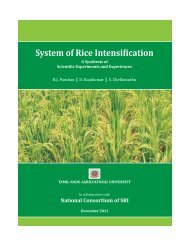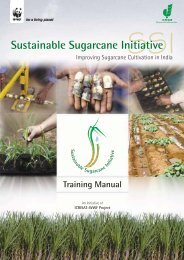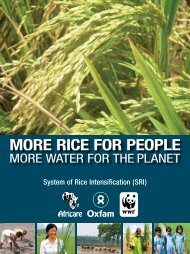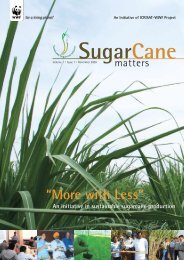SRI in Orissa - Cornell International Institute for Food, Agriculture ...
SRI in Orissa - Cornell International Institute for Food, Agriculture ...
SRI in Orissa - Cornell International Institute for Food, Agriculture ...
You also want an ePaper? Increase the reach of your titles
YUMPU automatically turns print PDFs into web optimized ePapers that Google loves.
decided to go ahead with it. I had not eye-witnessed<br />
any <strong>SRI</strong>-based cultivation, nor had any <strong>for</strong>mal tra<strong>in</strong><strong>in</strong>g,<br />
but its high yield potential and its new method was very<br />
<strong>in</strong>terest<strong>in</strong>g. I just applied my own ideas and understand<strong>in</strong>g<br />
<strong>for</strong> the experiment. After 35 years of farm<strong>in</strong>g experience I<br />
took up <strong>SRI</strong> as a challenge. I chose a small field of 0.27 acres<br />
and started implement<strong>in</strong>g <strong>SRI</strong> <strong>in</strong> Kharif 2005.<br />
Kharif 2005<br />
I followed the ma<strong>in</strong> <strong>SRI</strong> pr<strong>in</strong>ciples <strong>in</strong> my land. They <strong>in</strong>cluded<br />
transplant<strong>in</strong>g young seedl<strong>in</strong>gs, s<strong>in</strong>gle seedl<strong>in</strong>g per hill, gap<br />
between plant to plant at 25 x25, and alternate wett<strong>in</strong>g and<br />
dry<strong>in</strong>g <strong>in</strong>stead of flood<strong>in</strong>g the field. Because the seeds and<br />
roots of the seedl<strong>in</strong>gs should not be submerged <strong>in</strong> water I<br />
did not prepare a specific seedbed. I just used a part of the<br />
seedbed that I also used <strong>for</strong> conventional rice cultivation.<br />
As a practic<strong>in</strong>g organic farmer I usually prepare the seedbed<br />
very carefully with bountiful of manure and pay<strong>in</strong>g close<br />
attention to the water management. Also with the ma<strong>in</strong><br />
field preparation I just went ahead as I did usually, pay<strong>in</strong>g<br />
more attention to proper levell<strong>in</strong>g. I did not canalise the<br />
fields as they are only small <strong>in</strong> size, and made sure the bed<br />
rema<strong>in</strong>ed un-flooded.<br />
The variety I used <strong>for</strong> the first <strong>SRI</strong> experiment was Seshadri<br />
from Maharastra. I only used this because other f<strong>in</strong>e varieties<br />
were not available dur<strong>in</strong>g that time. I transplanted the<br />
seedl<strong>in</strong>gs after 11 days. At the time I was not yet aware of<br />
more technical components, so I neither marked nor measured<br />
the root length. With proper guidance to the labourers the<br />
transplant<strong>in</strong>g happened very carefully. Every 10 to 15 days I<br />
wetted the field, keep<strong>in</strong>g it wet and moist. Nearly 50% of the<br />
water requirement <strong>for</strong> traditional farm<strong>in</strong>g was saved.<br />
I used oil cake as fertiliser as I normally do, and I applied<br />
manure <strong>in</strong> a regular <strong>in</strong>terval of 10 days to get the<br />
nitrogen properly. I did not feel it was necessary to apply<br />
any pesticide, <strong>for</strong> which I usually take arecanut leaves.<br />
I did notice some pests <strong>in</strong> the field, but the disease did<br />
not affect other plants because of the distance between<br />
the plants. Moreover, s<strong>in</strong>ce I practice organic farm<strong>in</strong>g,<br />
the chances of pests are very much less as the plants<br />
usually are healthy. The biggest problem at the time was<br />
weed<strong>in</strong>g. I could not arrange a weeder and carried out<br />
manual weed<strong>in</strong>g only once after 30 days. Do<strong>in</strong>g it aga<strong>in</strong><br />
would have been too expensive, so I let it be. This was a<br />
mistake, as the weeds were comparatively higher than <strong>in</strong><br />
traditional crops.<br />
At the harvest<strong>in</strong>g stage Mr. Niranjan Nayak, an <strong>Agriculture</strong><br />
Scientist from KVK, Bhanjanagar, Ganjam, came with his<br />
team to note the yield rate of the <strong>SRI</strong> paddy. Mr. Nayak<br />
and his team estimated the yield to be 6.5 t/ha. They took<br />
a sample of 30 plants, 10 plants each from among the<br />
lowest, medium and highest gra<strong>in</strong>-carry<strong>in</strong>g plants, as I<br />
remember. The average number of tillers <strong>for</strong> the 30 plants<br />
counted was 37, and the maximum was 65. The growth of<br />
the plants was the same as <strong>in</strong> traditional paddy, as was their<br />
size. The panicles per hill were 19 (average of 30 plants),<br />
and the gra<strong>in</strong>s per panicle were 270 (average of 30 plants).<br />
The <strong>in</strong>stance of unfilled gra<strong>in</strong>s was equal as <strong>in</strong> traditional<br />
paddy, and the quality of hay was good. I did not f<strong>in</strong>d any<br />
notable differences between <strong>SRI</strong> rice and general rice. The<br />
colour and taste were the same, and no problems dur<strong>in</strong>g<br />
mill<strong>in</strong>g were reported. The rice output from <strong>SRI</strong> paddy was<br />
about 65% of the paddy milled, the same as <strong>in</strong> the case of<br />
traditional paddy.<br />
I do not know the exact <strong>in</strong>vestment <strong>in</strong> my 0.27 acres of land<br />
– it must have been around Rs. 600 – but clearly the costs<br />
differed <strong>in</strong> comparison with traditional methods <strong>in</strong> each<br />
and every item, i.e. seeds, water<strong>in</strong>g, fertiliser and harvest<strong>in</strong>g.<br />
As I already <strong>in</strong>dicated that the costs of the manual weed<strong>in</strong>g<br />
scared me, I stopped. If I could use a rotary weeder I could<br />
be able to reduce the expenses on weed<strong>in</strong>g, and also the soil<br />
could get more oxygen which would probably have led to<br />
higher yields. In traditional systems, expenditures per acre<br />
come to about Rs. 3500 and the <strong>in</strong>come from the paddy is<br />
normally Rs. 10,000 under a market price of Rs. 400 per bag<br />
and a yield of 25 bags. My <strong>SRI</strong> yield would be 35 bags per<br />
acre as I got 9.5 bags from 0.27 acre, and s<strong>in</strong>ce the costs<br />
would be about Rs. 1800 per acre, my <strong>in</strong>come would <strong>in</strong>crease<br />
almost twofold. This could be higher, if more technically<br />
correct cultivation was done with a f<strong>in</strong>e seed variety. And I<br />
did not even <strong>in</strong>clude the <strong>in</strong>come from the straw, which was<br />
doubled with <strong>SRI</strong>.<br />
Rabi 2005-2006<br />
As <strong>in</strong> Kharif, I applied <strong>SRI</strong> <strong>in</strong> Rabi as well but this time with<br />
a larger area, i.e. 0.5 acres of land. Although there were<br />
no real problems of water scarcity due to the canal, I had<br />
problems controll<strong>in</strong>g weeds that grew plentiful due to the<br />
dryness of the field. Aga<strong>in</strong> I tried hard to arrange a cono<br />
weeder. I heard that Rangeilunda, Ganjam had a weeder so<br />
I went there, but com<strong>in</strong>g there I was harassed due to the<br />
absence of a salesman. Meanwhile the weeds <strong>in</strong> the field<br />
were so high and the manual weed<strong>in</strong>g became so expensive<br />
66<br />
Towards a Learn<strong>in</strong>g Alliance: <strong>SRI</strong> <strong>in</strong> <strong>Orissa</strong>
















